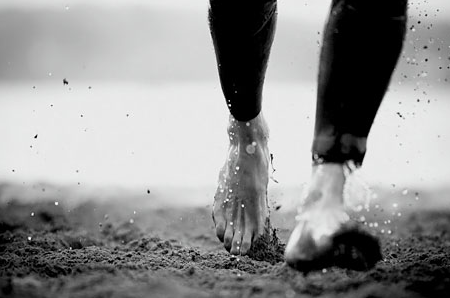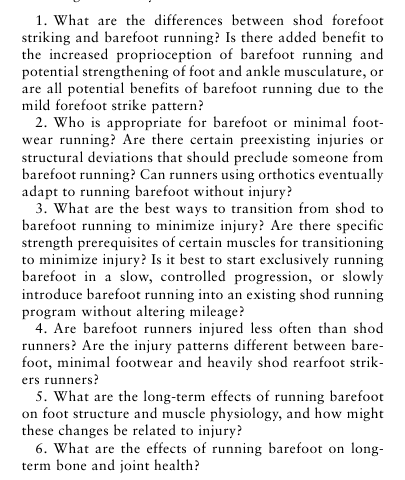 Review and Summary of the Following Published Study:
Review and Summary of the Following Published Study:
BioMechanics of Barefoot Running: Biomechanics and Implications for Running Injuries, by Allison R. Altman and Irene S. Davis.
Sports Medicine in Current Sports Medicine Reports,
American College of Sports Medicine, Volume 11 · Number 5, September/October 2012, pp.244-250.
***
by Jim Hixson.
Well-known researcher and author Irene S. Davis (Harvard University) and her graduate student at the time Allison R. Altman (University of Delaware) teamed to write an excellent review on where we are with barefoot running. Dr. Davis has extensively studied the correlation between multiple variables: footwear, running form, and rates of injuries.
After a short summary of our best hypotheses regarding running and the evolutionary development of the species, the obvious, but important fact is stated: “Regardless of why we began to run, we clearly began running without shoes”. Although there is an archaeological record of shoes that goes back over 10,000 years, there is no evidence that runners before the late 1970s used shoes like today’s best-selling models. Many studies could be stopped now, if only we had the running logs and injury records for our ancient ancestors. With that information we could quickly determine whether or not the billions of dollars spent on technologically sophisticated running shoes has had a positive or negative effect on running injuries, or perhaps no effect at all.
The next section of the article deals with the effects modern running shoes have on biomechanics. When considering “…a dual-density midsole, elevated, cushioned heel, arch support, stiff heel counter, and an array of other features purported to assist in foot function and reduce injury”, the authors make the important conclusion we have learned to anticipate: “The benefits of these technological advances on injury prevention have not been documented.”
Since most runners wearing traditional shoes contact the ground heel first and most barefoot runners land forefoot first, a comparison of these two styles and their respective effects on impact peak, muscular involvement, and stride length is the subject of the next section. Obviously the two running styles result in different running experiences, but how do they affect injury rates? Ever since Daniel Lieberman showed a qualitative difference between strike patterns of forefoot striking and rearfoot striking (2010), supporters of traditional running shoes have claimed that these differences do not lead to higher injury rates for rearfoot strikers. As Altman and Davis report, however, another study by Lieberman, published in early 2012, “…showed that mild and moderate running-related injuries occurred 2.5 times more frequently in rearfoot strikers than in forefoot strikers.”
The next three sections are probably the most interesting for those readers who are already well acquainted with the literature on foot strike, vertical ground reaction force, and shock attenuation. The main questions are: Do truly minimal shoes, such as the Vibram FiveFingers, Merrell Road Glove, and Vivo Barefoot Evo, provide the same benefits as running barefoot? Does running in a minimal shoe lead to a style of running that is the same as running without shoes? Will running in minimal shoes lead to lower injury rates for injuries suffered by traditionally shoe runners? The answers are “No”, “No”, and “No” for some people, but “Most”, “Yes”, and “Yes” for others. So, now that everything is crystal clear, what are the major differences between barefoot running and wearing minimal shoes while running?
Possibly the greatest benefit of running barefoot is the ability of the neuromuscular system to receive more sensory input, whereas even “…socks likely filter out some of the important sensory input coming from the mechanoreceptors in our feet.” In the next paragraph the authors attempt to give some hope to runners who wear minimal shoes, when they state that “it is still unclear as to whether they truly mimic barefoot running.” Two paragraphs later they destroy this hope: “Without sensory feedback between the sole of the foot and the surface of the ground…the runner may not have the complete neural cueing to convert to a forefoot strike pattern” and “even the thin rubber outer sole offered some protection to the heel to allow them to land on it.”
Barefoot runners, in my experience, often run barefoot all the time, that is, in all conditions, so they can tell others that they always run barefoot. Those who run in minimal shoes claim to be more pragmatic, claiming that they have found a middle way, allowing them to run basically barefoot comfortably in almost all situations. Runners who wear traditional shoes think that both these groups are constantly flirting with danger and no matter what supposed advantages might be gained by running barefoot of wearing shoes that allow the foot to move naturally will soon incur career-ending injuries and be removed from the running gene pool.
From my own reading between the lines, it seems that the authors and other researchers believe that a combination of running barefoot and running in true minimal shoes is probably the alternative that will allow you to run most efficiently, improve performance and reduce the chances of injury. Theoretically we should always run barefoot, but theoretically I once tried to run barefoot on an old lava bed and afterwards my feet were in terrible medical shape. If we all lived on golf courses or soft dirt and the temperature was mild, then running barefoot should always be the option chosen. Since that is not the case, let’s look at our feet the way we look at our hands.
Certainly we can agree that our hands have evolved to move without outside support or protection. With the exception of sufferers from circulatory or skin diseases, I don’t know anybody who would wear gloves on a nice, bright, sunny day. But I also don’t know many people who would intentionally walk outside on a freezing cold day or grab a hot pan off the stove without protecting their hands. Shoes and gloves are used to cover similar parts of the body. Neither shoes nor gloves should be seen as “tools”, rather they are pieces of clothing that allow us to go places and accomplish tasks that we could not do otherwise comfortably or safely.
The authors close their article with a list of about a dozen questions about barefoot running that still need to be more thoroughly addressed. See list here:
And here are my own answers to their important questions, or what I think they will be, if and when the research eventually has been done.
–It is preferable to barefoot, because that is our natural condition, the one in which we have evolved over millions of years to exist.
–There are certain advantages that can only be gained from being barefoot. There are, however, situations which should encourage us to wear minimal protection, just enough to prevent injury from the surface or the elements.
–Minimal shoes should not restrict our natural range of movement.
–Alternating between barefoot and minimal shoes should allow us to retain the benefits we have gained from being barefoot.
–Just because one is barefoot or wearing minimal shoes does not mean that person will necessarily have good running form, but wearing a traditional shoe precludes this possibility.
–The potential dangers associated with wearing traditional running shoes far outweigh the temporary problems connected with switching from traditional shoes to barefoot or minimal shoes and these problems can be lessened by providing for an adequate transition.
–The philosophy we have towards being barefoot and wearing minimal shoes should be applied to the rest of our lives, not just the time when we are exercising.
I think all of the questions posed by Allison Altman and Irene Davis will be answered sooner rather than later. Judging from the number of recent publications, there are so many more scientists interested in the different aspects of running barefoot and minimal footwear than there were even two years ago. There are also millions of “experiments of one” who are providing anecdotal accounts that will spur further research. The next few years should be exciting for all runners.


awesome article
Great article. I am still convinced of all the benefits of barefoot running biomechanic wise. It prevents a lot of classical runner injuries. Just as an example like this article is stating:
http://www.calendarofmarathons.com/barefoot-running-biomechanics/
“After an hour of running, the feet heat up and expand by 8% and 15 grams of sweat. This discomfort felt inside a shoe is unknown to barefoot runners”